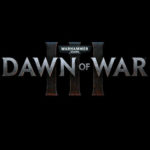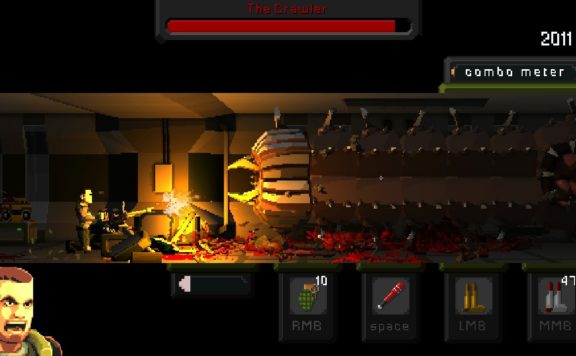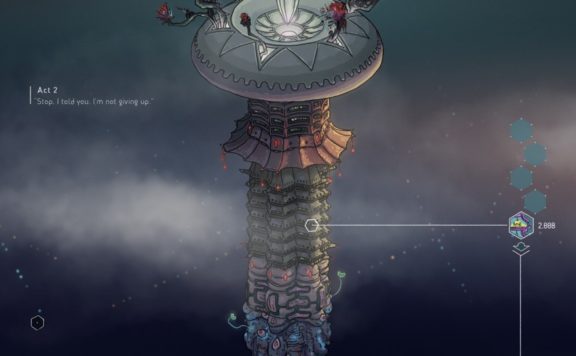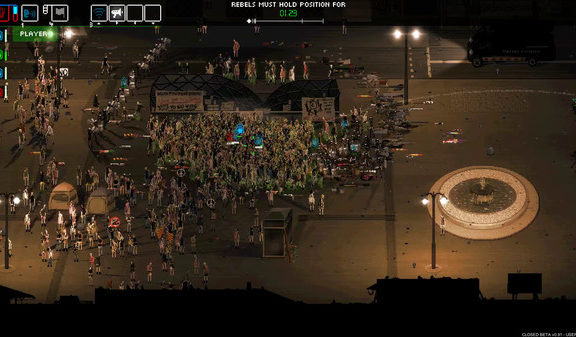Relic’s Dawn of War series has been one of my absolute all-time favorite RTS experiences. I remember, clearly, learning about the Warhammer 40,000 universe through the auspices of my college roommate, who convinced me to pick up Dawn of War and gave me a crash course in the lore. For the record, he was a big fan of the Tau, but I immediately fell in love with the armies of Chaos. He and I spent hundreds of hours playing skirmishes against each other, and I pounced on each expansion with all of the fervor of a hungry dog with an unattended Five Guys hamburger. This is our Warhammer 40K Dawn of War 3 review.
Dawn of War II was an even bigger eye-opener for me. Relic has always sought to refine and redefine the RTS experience, and their slew into a more tactical territory really excited me. The almost pure focus on unit interactions and map control really spoke to me in a visceral way, as did the charging/jumping/teleporting/tunneling – simply the way things moved around the map was itself interesting and exciting, and a real departure from how most mainstream RTS approached things.
How does Dawn of War III fit into this picture? Well… while Relic’s latest Dawn of War game does draw some inspiration from its predecessors, it often goes in radically different directions. Some hardcore fans of the series have been turned off by what they’ve seen, or what they’ve heard about the game. But that doesn’t mean that Dawn of War III isn’t a good game. Let’s dive in and take a look at the highs, the lows, and the giant death robots.
Clarity
 Dawn of War III has the soul of a Relic game, but that soul is enshrouded with layers of meat and muscle that borrow more from Blizzard than they do from Relic’s past titles. Relic’s trademark cover and retreat mechanics are gone, as are percent chances to hit and random damage effects: depending on how you look at it, they’ve either made the game easier to understand, or just stripped out the complexity. If a unit shoots at something, it’s going to hit, and that damage is going to be the same no matter what: in previous Relic games, random effects and miss chances were constantly cursed as negatively impacting the course of a game for a player or a team.
Dawn of War III has the soul of a Relic game, but that soul is enshrouded with layers of meat and muscle that borrow more from Blizzard than they do from Relic’s past titles. Relic’s trademark cover and retreat mechanics are gone, as are percent chances to hit and random damage effects: depending on how you look at it, they’ve either made the game easier to understand, or just stripped out the complexity. If a unit shoots at something, it’s going to hit, and that damage is going to be the same no matter what: in previous Relic games, random effects and miss chances were constantly cursed as negatively impacting the course of a game for a player or a team.
And to me, the story of Dawn of War 3 is one of a pursuit of clarity. Relic took great pains to make the role of each unit clear, the effect of each ability understandable (though some abilities are quite complex in their application, and can take a while to learn how to use them gracefully), and the impact of each choice painfully clear. In the case of combat “painful” can be literal at times.
Without the ability to retreat, combat can actually be a lot less forgiving than in previous Relic games. Bad decisions can lead to the loss of squads and armies much easier, a bitter pill made more palatable because Relic’s made it much easier to rebuild armies than in previous titles.
 Abilities are fun and flashy, ranging from standard fare like grenades and infantry charges to more exotic Elite unit abilities. For example, one Eldar Elite, Macha, has 2 auras, and can also throw her spear. When she throws her spear, it embeds in the ground and becomes the center point of her auras. Also, while Macha is alive, she has a passive effect that can delay the death of the player’s other Elite units. So, while some of the mechanics have been “simplified” it doesn’t necessarily mean the game has become simple.
Abilities are fun and flashy, ranging from standard fare like grenades and infantry charges to more exotic Elite unit abilities. For example, one Eldar Elite, Macha, has 2 auras, and can also throw her spear. When she throws her spear, it embeds in the ground and becomes the center point of her auras. Also, while Macha is alive, she has a passive effect that can delay the death of the player’s other Elite units. So, while some of the mechanics have been “simplified” it doesn’t necessarily mean the game has become simple.
Much of the gameplay will feel similar to anyone who’s played the original Dawn of War, or Company of Heroes 2. Hardcore fans of the previous titles might be disappointed that combat has more churn (a fancy way of saying that your units die a lot more often) and will definitely have strong opinions about the loss of the cover system and retreat mechanics. But I find the game approachable, engaging, understandable, brutal, and… addictive. I can’t remember the last time I was so ready to queue up for match after match after match like I have been with Dawn of War III – I tend to suffer from “ladder anxiety” in RTS, and marathon sessions of Legacy of the Void or Company of Heroes 2 give me heart palpitations. Dawn of War III has managed to soothe that beast, at least for now.
Graphics
 Ok. So Dawn of War III looks pretty good – the maps are pretty, and some fun stuff is done with three-dimensionality: in the first campaign mission, for example, the player is sent up to the top of a large structure, and they can see combat down below on the ground in the background as they’re plowing through hordes of Orks. It’s a pretty neat visual experience. But there are some quirks: units almost have a StarCraft 2 vibe about them: detail is overall lower and definitely feels more cartoony than players of the previous Dawn of War games might have wanted. Some animations, like the Wraithguard’s attack, look a little silly if you stop still to pay attention to them. But, I have to say: Dawn of War III runs better or my middling hardware than Company of Heroes 2 does, which is definitely something. Bottom line, the visuals are better than decent but can sometimes surprise you in disappointing ways.
Ok. So Dawn of War III looks pretty good – the maps are pretty, and some fun stuff is done with three-dimensionality: in the first campaign mission, for example, the player is sent up to the top of a large structure, and they can see combat down below on the ground in the background as they’re plowing through hordes of Orks. It’s a pretty neat visual experience. But there are some quirks: units almost have a StarCraft 2 vibe about them: detail is overall lower and definitely feels more cartoony than players of the previous Dawn of War games might have wanted. Some animations, like the Wraithguard’s attack, look a little silly if you stop still to pay attention to them. But, I have to say: Dawn of War III runs better or my middling hardware than Company of Heroes 2 does, which is definitely something. Bottom line, the visuals are better than decent but can sometimes surprise you in disappointing ways.
Elites, Doctrines, and Customization
 Relic has been toying around with army customization systems since at least their canned Company of Heroes Online days. Both Dawn of War 2 and Company of Heroes 2 feature such “meta” or outside-the-match customization systems: Dawn of War 2 allows you to pick a hero unit, and Company of Heroes 2 uses a system called “commanders” that basically unlock a set of pre-defined units, upgrades, or abilities.
Relic has been toying around with army customization systems since at least their canned Company of Heroes Online days. Both Dawn of War 2 and Company of Heroes 2 feature such “meta” or outside-the-match customization systems: Dawn of War 2 allows you to pick a hero unit, and Company of Heroes 2 uses a system called “commanders” that basically unlock a set of pre-defined units, upgrades, or abilities.
They seem to have hit their stride with Dawn of War III – its system is like a synthesis of the 2 I mentioned previously. First, the player can pick from 9 different Elite units, ranging from and Ork Meganobz squad to Space Marine Venerable Dreadnaught, or Eldar Striking Scorpions, to individual characters like a Weirdboy, a Librarian, or an Eldar Howling Banshee Elite: Jain Zar. There are, of course, also the so-called Super Elites: the Wraithknight, Morknaut, and Imperial Knight. Each Elite unit has a cost associated with it relative to its power: weaker ones might cost 2 Elite Points, while the heaviest ones cost 9. In an effort to prevent players from just loading up on the heavy Super Elites and wrecking everything, it actually takes a long time to accrue Elite Points, forcing choices on the player in-match whether they think they can hold off to a Super Elite, or purchase cheaper Elite Units to keep them afloat in the short to mid-term. I personally like fielding a larger array of cheaper Elite units early in a match, so I can gain and keep an early advantage.
Along with Elites are Doctrines, which are passive bonuses ranging from giving a unit type more armor, to actually unlocking defensive structures. Doctrines (of which players can only bring 3 into battle) can really change a player’s toolset in battle and are pretty interesting to experiment with.
MOBA What now?
 One of the game’s biggest controversies is its victory condition. Relic’s RTS have kind of popularized the “victory point” style win condition: capture certain points on the map, and you start to gain a trickle of points. The first player to hit the magic points number, wins. Dawn of War 2 flipped this on its head a bit: in DOWII, you’re reducing your opponents points to 0 instead of building up your own, but that’s functionally the same thing. Dawn of War 3… does not do this.
One of the game’s biggest controversies is its victory condition. Relic’s RTS have kind of popularized the “victory point” style win condition: capture certain points on the map, and you start to gain a trickle of points. The first player to hit the magic points number, wins. Dawn of War 2 flipped this on its head a bit: in DOWII, you’re reducing your opponents points to 0 instead of building up your own, but that’s functionally the same thing. Dawn of War 3… does not do this.
In Dawn of War 3, each team has 2 Shield Generators, 2 Turrets, and a core structure. Similar to MOBAs, players have to kill these to win. More specifically, each Shield Generator protects its paired turret, and the turrets protect the Core. So you have to kill a generator, then it’s paired turret, and only once at least one turret has been killed is the Core vulnerable. It’s a bit complex to explain, and takes a bit to get used to, as well.
Players’ mileage on this might vary. I prefer the Victory Points system, but still, find this enjoyable (those turrets are a pain in the tuckus to take down!). Ultimately, I feel like the game still *feels* like a strategy title, but there are assuredly some for whom this change in direction will be a deal breaker.
Campaign
 I’ve spent a long time talking about the game’s mechanics, but most people play RTS for campaign and skirmish. The campaign is fun, and I’m glad that Relic allows the player to experience all 3 factions: each level puts the player in the boots of a different faction, round-robin style. Most Relic games focus entirely on only one of their game’s factions, so this is a welcome change. I’ll admit that personally, I’m not a huge fan of the Orks’ play style at this point, I tend to stop playing the campaign for a while every time I hit an Ork mission.
I’ve spent a long time talking about the game’s mechanics, but most people play RTS for campaign and skirmish. The campaign is fun, and I’m glad that Relic allows the player to experience all 3 factions: each level puts the player in the boots of a different faction, round-robin style. Most Relic games focus entirely on only one of their game’s factions, so this is a welcome change. I’ll admit that personally, I’m not a huge fan of the Orks’ play style at this point, I tend to stop playing the campaign for a while every time I hit an Ork mission.
The campaign makes me think of… Price constraints, honestly. While the opening cinematic is fun (it loses its appeal after the second or third time you see it, if I’m being honest) in-game, there are in-game scripted cinematics and animated comic-style voiceovers. It’s not bad, but it’s not what people might expect of a Dawn of War title. I got more mileage out of the previous Dawn of War campaigns. Personally, I’d love to see something like Ardennes Assault from Company of Heroes 2.
In Conclusion
Dawn of War III is a solid RTS title in its own right. It is a pretty big departure for Relic in terms of mechanics, and that might not sit right with some players. But it hits a lot really great notes. Whether you enjoy it might be a factor of just what it is you love about Relic’s games and about RTS in general, but I can see myself happily playing it for years to come.
Note: This review was performed on PC with a code provided by SEGA PR. It was written by Brandon “Wayward Strategist” Casteel.








Aori
The game appears to have been made to bring in a new audience to the genre. This from my experience and friends I’ve talked with does not appeal to either the DoW1 or DoW2 fanbase. Personally it is truly disappointing.
wayward_designer
I’m not sure that it’s designed to bring a new audience to the genre per se, but that it was designed to make Relic’s formula more generally approachable and understandable. Like I said in the article, DOW II occasionally had collision issues (as with the Zoenthrope’s artillery attack) and COH 2 has issues regarding its RNG systems, where people feel that RNG situations (buildings collapsing, random effects when vehicles are damaged etc) can cost them wins. I think many of the changes (some of which I mind and some of which I don’t – I miss DOW II’s destructible terrain and cover even while thinking it wouldn’t work well in this game) are directly in line with complaints like those.
Others, like the “MOBA” style win condition, are probably at least partially in the hopes of attracting players familiar with that style of combat. But for me, it meets the criteria of “enemy as obstacle” which is my preferred win condition method even if DOW III does it in a different way than I prefer.